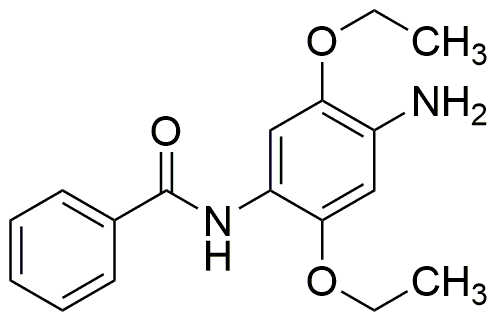Azoic diazo component 20 (Base) is widely utilized in research focused on:
- Dye Manufacturing: This compound serves as a key ingredient in producing azo dyes, which are widely used in textiles, plastics, and food industries due to their vibrant colors and stability.
- Analytical Chemistry: It is employed in various analytical methods, including spectrophotometry, to detect and quantify substances, making it invaluable for quality control in laboratories.
- Pharmaceuticals: The compound plays a role in synthesizing intermediates for pharmaceuticals, contributing to the development of new medications with improved efficacy.
- Polymer Chemistry: It is used in the formulation of polymeric materials, enhancing properties such as color and stability, which are essential in manufacturing durable goods.
- Research Applications: In academic and industrial research, it aids in the study of reaction mechanisms and the development of new chemical processes, providing insights that drive innovation.
General Information
Properties
Safety and Regulations
Applications
Azoic diazo component 20 (Base) is widely utilized in research focused on:
- Dye Manufacturing: This compound serves as a key ingredient in producing azo dyes, which are widely used in textiles, plastics, and food industries due to their vibrant colors and stability.
- Analytical Chemistry: It is employed in various analytical methods, including spectrophotometry, to detect and quantify substances, making it invaluable for quality control in laboratories.
- Pharmaceuticals: The compound plays a role in synthesizing intermediates for pharmaceuticals, contributing to the development of new medications with improved efficacy.
- Polymer Chemistry: It is used in the formulation of polymeric materials, enhancing properties such as color and stability, which are essential in manufacturing durable goods.
- Research Applications: In academic and industrial research, it aids in the study of reaction mechanisms and the development of new chemical processes, providing insights that drive innovation.
Documents
Safety Data Sheets (SDS)
The SDS provides comprehensive safety information on handling, storage, and disposal of the product.
Product Specification (PS)
The PS provides a comprehensive breakdown of the product’s properties, including chemical composition, physical state, purity, and storage requirements. It also details acceptable quality ranges and the product's intended applications.
Certificates of Analysis (COA)
Search for Certificates of Analysis (COA) by entering the products Lot Number. Lot and Batch Numbers can be found on a product’s label following the words ‘Lot’ or ‘Batch’.
*Catalog Number
*Lot Number
Certificates Of Origin (COO)
This COO confirms the country where the product was manufactured, and also details the materials and components used in it and whether it is derived from natural, synthetic, or other specific sources. This certificate may be required for customs, trade, and regulatory compliance.
*Catalog Number
*Lot Number
Safety Data Sheets (SDS)
The SDS provides comprehensive safety information on handling, storage, and disposal of the product.
DownloadProduct Specification (PS)
The PS provides a comprehensive breakdown of the product’s properties, including chemical composition, physical state, purity, and storage requirements. It also details acceptable quality ranges and the product's intended applications.
DownloadCertificates of Analysis (COA)
Search for Certificates of Analysis (COA) by entering the products Lot Number. Lot and Batch Numbers can be found on a product’s label following the words ‘Lot’ or ‘Batch’.
*Catalog Number
*Lot Number
Certificates Of Origin (COO)
This COO confirms the country where the product was manufactured, and also details the materials and components used in it and whether it is derived from natural, synthetic, or other specific sources. This certificate may be required for customs, trade, and regulatory compliance.


